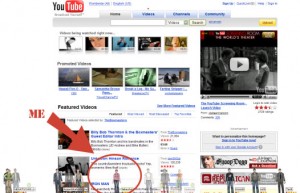 For the past several months, I have been experimenting with a little-known web application called Weblin. In effect, it allows you to have a little avatar (Weblin) that appears on any web site you visit. This avatar can then see and communicate with other Weblins it encounters on that site. In essence, Weblin turns your web browser into an online social medium all its own.
For the past several months, I have been experimenting with a little-known web application called Weblin. In effect, it allows you to have a little avatar (Weblin) that appears on any web site you visit. This avatar can then see and communicate with other Weblins it encounters on that site. In essence, Weblin turns your web browser into an online social medium all its own.
As you might suspect, more Weblins congregate around the more popular sites. Visit, for example, Google or YouTube or Twitter with your Weblin and you will invariably see a fair number or even a crowd of others visiting those sites. While you’re there, you can cause your Weblin to perform various actions, including dancing, waving, laughing, yawning, clapping and more. Your Weblin can also, of course, chat or private message with other Weblins. You can also “wousle” them, which is a way for a Weblin to introduce themself. You also have the option to make another Weblin a contact, so that you can see when they are online. There are also other interactive features, such as being able to maintain an inventory of items which you can trade with other Weblins.

What I LIKED about Weblin
- The potential is interesting. It gives a new visual dimension to text chat by using avatars. I could maybe see a library using something like this for casual questions from patrons.
- You can right-click on any Weblin to see their profile. This may help you identify who could be interesting to talk to. However, the Weblin web site records who looks at a profile, so this cannot be done anonymously.
- A lot of the Weblin community is not from the U.S. Many Weblins show a little flag next to them to indicate country of origin. As far as nationality goes, it’s a fairly diverse user base.
- The ability to take a web page and mail it directly to yourself is perhaps the only major practical add-on of this application.
WHAT I DISLIKED about Weblin
- Perhaps it would have been different if I had a male avatar, but the vast majority of communications I received revolved around whether or not I was a potential dating prospect.
- Personally, I found the Weblin site to be confusing at times. For example, the link to “Shop” does not allow one to shop for new inventory items, but instead is a way for a Weblin to create a shop of their own.
- The sound effects will likely drive one crazy. Every time someone chats, a sharp tweet can be heard and it’s grating. The static-like noise when Weblins appear is also annoying. It often got to the point where I just turned Weblin off entirely.
- In the 2-3 months I’ve been using Weblin, I never found anyone I really wanted to maintain contact with (back to my first point in this list, which points out that most Weblins were just hitting on me). I did run into someone I knew from the Netherlands once (and I didn’t know he had a Weblin).
- <PERSONAL NOTE>Frankly, I was just a little creeped out…and I’m not exactly the shyest person on the planet. Knowing that all these other people were seeing the same thing I was seeing in some fashion was a little unnerving. </PERSONAL NOTE>
Overall, I was just not that impressed with this as a service. I am forced to relegate it to the realm of “Has Potential, Is Kind of Cute, That’s It.” Patrons of Ohio’s libraries are most likely not aware of Weblin and there is no real compelling reason to have one, other than to experiment.
WHAT DOES THIS MEAN TO ME, LAURA?
- This is not (at least, not yet) a service that really is useful for public libraries.
- Having a female avatar is less likely to be productive than having a male one, IMHO.
- The “Send webpage as email” function is unique enough that I’m leaving Weblin installed for use, as needed.
- This application has a long way to go to make it more usable for the general public.